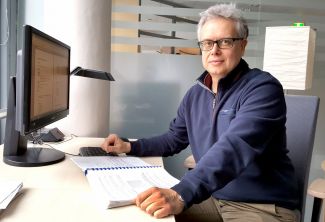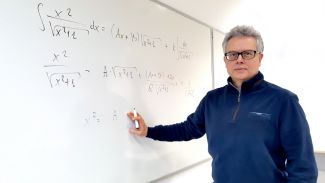Whereas mathematics inevitably brings to mind a tough school subject and lessons you only wish to forget about once you have left school, it turns out that when it comes to looking for love it might as well come to our aid. How could that be possible? Dr inż. Jakub Szczepaniak, an extraordinarily popular teacher who works at TUL's International Faculty of Engineering (IFE) and Center for Mathematics and Physics, explains.
Does math help us in the nitty-gritty of our everyday lives?

For about 50 years, mathematicians have been trying to forecast the weather, and while at it, they have managed to develop Chaos Theory and some very appealing concepts such as the butterfly effect, strange attractor and bifurcation. States of love cannot be simpler than states of weather conditions. Love is somewhat like an aura: weather conditions of our souls and our bodies. Although predicting hurricanes, cyclones, and other elemental changes is still far from perfect, modelling phenomena that occur in less complicated climate zones has indeed been mastered by mathematicians and meteorologists. The same goes for love. When you are trying to represent typical states of behaviour it seems tempting to develop a system of equations to describe the state of affection of people in love.
Love equation - what does it mean and how do you solve it?
Mathematicians have been toying with modelling a system of love with differential equations since the 1980s. When you can measure the values of your feelings in time and observe how these values change, then you can introduce the concept of happiness as a derivative of the feeling. Next, you watch yourself and the person you are in love with and you try to observe each other's reactions to changes in your and their mood. The next stage is to decide what partner types you represent. 16 dating personality types have been defined, the following being the most common ones:
- eager, insatiable, forthcoming,
- narcissistic, showing off, self-centered,
- cautious, conservative, neurotic,
- withdrawn, stern, morose.

Once we get to know each other the emotional relationship of the people in love can be described with a system of simple differential equations. You can play around with predicting the future, which means you can try to determine what the values of the lovers' feelings will be after a period of time. It is just an amusement but it can also be very rewarding when you can relate some of the observations you have made while tracking each other's feelings' functions in time to your actual behaviour.
We will show you what happiness looks like to analysts, and, based on simulations, what you can do to prolong the satisfaction and joy of experiencing positive emotions on one hand, and on the other, reduce the bitter aftertaste of defeat in your private or professional life – that is how you encouraged people to take part in workshops - a pretty unusual way of asking people to come and study mathematics. What is the mathematical formula for happiness then?
I bet I will surprise you, and, because that we are having this conversation on the occasion of Valentine’s Day, I will present you with a short and concise mathematical remedy. We all have two individual parameters that characterise Nauka movie- dr inż. Jakub Szczepaniakchanges in happiness:
B – an indicator of how quickly one recovers from a sudden change; personal coefficient of resistance, suppression of feelings, and
W – intrinsic, individual frequency of changes in mood and emotions. In time, we tend to experience unintentional mood changes inexplicable by any external stimuli.
The primary conclusion that can be drawn from the happiness equation is that we should try to keep these two variables in balance. In happy mathematicians the values of B and W tend to be closely related.
In what other ways can mathematics be useful?
The language of mathematics allows you to describe certain phenomena in such a way so as to make them appear more formidable and serious than they actually are. On the other hand, you can also use it to talk about very complex and weighty topics in a straightforward and, hopefully, understandable manner. That is where the underappreciated power of maths lies. I will give you two examples.
One to illustrate how straightforward mathematics can be, while the other to show how vague and subtle, too. The examples will be directly related to the holiday we just celebrated. Mathematics makes it possible:
To see a World in a Grain of Sand
And a Heaven in a Wild Flower,
Hold Infinity in the palm of your hand
And Eternity in an hour.
And this is how you can express your most secret feelings:
You are the fairest of your sex
Let me be your hero
I love you as one over x
As x approaches zero.
Mathematics can be tough for some students. What advice would you give them?

The mathematics experienced by people for whom it is not professionally relevant appears to them mainly as one of the school subjects that become part of their life when they start primary school until, in some cases, they graduate from a university. It is generally considered a difficult, useless, disconnected from reality and, most of all, spiritless science. By and large, we tend to think that basic knowledge of arithmetic and fundamentals of geometry is sufficient to live a normal life and not to worry about the lack of other mathematical skills. We do not feel ashamed of deficiencies in our mathematical knowledge or skills. We are adamant about making do without it and tend to think that the only point of learning formulae and theorems was to improve the flexibility and function of our memory. All in all, a memorized poem may come in handy, whereas reciting Rolle's theorem is unlikely to impress anyone.
We need to bear in mind that it is mathematicians who develop mathematics. Their stories are fascinating and worthy of getting to know better. We might as well try and tell our students a few stories of the cloak-and-dagger genre, of betrayal and duels fought in the name of love the main characters of which were mathematicians. Let's study and teach mathematics through the prism of its heroes.
Many mathematicians collect mathematical jokes and, even though it may seem like a failure to the joke teller, they might want to explain some of them to their students, and hope a ghost of a smile appears on their faces. This way we might be able to convince people that mathematics is not forbidding, fossilized and useless.
It is worth being a scientist because ...
from a mathematician's perspective, it is because, every day, you get a chance to experience something new, work out new ideas. Any person that is involved in mathematics, even amateurs, gets an opportunity to discover something and to be amazed by the exactitude of the description of the world around us and its phenomena.Whereas mathematics inevitably brings to mind a tough school subject and lessons you only wish to forget about once you have left school, it turns out that when it comes to looking for love it might as well come to our aid. How could that be possible? Dr inż. Jakub Szczepaniak, an extraordinarily popular teacher who works at TUL's International Faculty of Engineering (IFE) and Center for Mathematics and Physics, explains.
